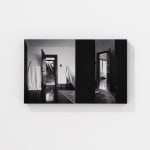Sun Young Kang
Door III, 2024
Inkjet print on fine art paper, mounted on wood board
10 x 16 x 1 1/2 in
25.4 x 40.6 x 3.8 cm
25.4 x 40.6 x 3.8 cm
Edition of 2 plus 1 artist's proof
SK0033
Copyright The Artist
Further images
Part of Sung Young Kang's series Memories, Veiled (2024). Kang took a series of photographs during her residency last winter at the mansion of Yaddo in Saratoga Springs, NY. Inspired...
Part of Sung Young Kang's series Memories, Veiled (2024).
Kang took a series of photographs during her residency last winter at the mansion of Yaddo in Saratoga Springs, NY. Inspired by a picture capturing the artist's late mother almost tied in her bed, all covered by translucent plastic curtains, "Memories, Veiled" represents Kang's visual exploration of "the room" within the mother's mind during her final years, when she was isolated due to Alzheimer's and the pandemic. It reflects her sense of isolation, longing, and struggle, as well as the uncertain reality and confusion she likely experienced. Additionally, it serves as a visual contemplation of the artist's own recurring dreams and the feelings of being unable to communicate, access, or understand her mother.
About Yaddo and the mansion:
Following the successive deaths of all four of their children, financier Spencer and writer Katrina Trask in 1900 bequeathed the near entirety of their considerable fortune toward establishing an artists' retreat on their rambling estate in Saratoga Springs, New York.
The artists' retreat opened its doors in 1926. Lodged during the summer in the estate’s imposing main house—known aptly as the Mansion—plus various all-season outbuildings, Yaddo’s fellows have come to represent a virtual who’s who in American arts—from writers James Baldwin to Jayne Anne Phillips, composers Leonard Bernstein to Laurie Anderson, visual artists Milton Avery to Terry Adkins.
The Trasks founded the Corporation of Yaddo with a clear and simple mission—to give uninterrupted time and space to artists. More importantly, they had a profound understanding of why Yaddo was urgent and necessary. They shared with others of their time and class a deep anxiety about social conditions, about the rise of fascism and concomitant wars, about what Katrina referred to as the “hardening of man’s soul and a growing deafness to the cries of the many and wisdom of the artist.” Yaddo was to be the antidote. It was to offer working writers and artists sanctuary—a respite from urbanization, income inequality, the demands of the marketplace, noise, political and economic upheaval. In the century since the Trasks inaugurated Yaddo, these factors have only intensified, and the need for artists to have a place of retreat to dive deeply into their work is more necessary now than ever before.
(Source: Yaddo official website; Architecture Digest, by Anne Korkeakivi)
For more history, consult Yaddo: Making American Culture, edited by Micki McGee. The New York Public Library holds the Yaddo archive.
Kang took a series of photographs during her residency last winter at the mansion of Yaddo in Saratoga Springs, NY. Inspired by a picture capturing the artist's late mother almost tied in her bed, all covered by translucent plastic curtains, "Memories, Veiled" represents Kang's visual exploration of "the room" within the mother's mind during her final years, when she was isolated due to Alzheimer's and the pandemic. It reflects her sense of isolation, longing, and struggle, as well as the uncertain reality and confusion she likely experienced. Additionally, it serves as a visual contemplation of the artist's own recurring dreams and the feelings of being unable to communicate, access, or understand her mother.
About Yaddo and the mansion:
Following the successive deaths of all four of their children, financier Spencer and writer Katrina Trask in 1900 bequeathed the near entirety of their considerable fortune toward establishing an artists' retreat on their rambling estate in Saratoga Springs, New York.
The artists' retreat opened its doors in 1926. Lodged during the summer in the estate’s imposing main house—known aptly as the Mansion—plus various all-season outbuildings, Yaddo’s fellows have come to represent a virtual who’s who in American arts—from writers James Baldwin to Jayne Anne Phillips, composers Leonard Bernstein to Laurie Anderson, visual artists Milton Avery to Terry Adkins.
The Trasks founded the Corporation of Yaddo with a clear and simple mission—to give uninterrupted time and space to artists. More importantly, they had a profound understanding of why Yaddo was urgent and necessary. They shared with others of their time and class a deep anxiety about social conditions, about the rise of fascism and concomitant wars, about what Katrina referred to as the “hardening of man’s soul and a growing deafness to the cries of the many and wisdom of the artist.” Yaddo was to be the antidote. It was to offer working writers and artists sanctuary—a respite from urbanization, income inequality, the demands of the marketplace, noise, political and economic upheaval. In the century since the Trasks inaugurated Yaddo, these factors have only intensified, and the need for artists to have a place of retreat to dive deeply into their work is more necessary now than ever before.
(Source: Yaddo official website; Architecture Digest, by Anne Korkeakivi)
For more history, consult Yaddo: Making American Culture, edited by Micki McGee. The New York Public Library holds the Yaddo archive.





